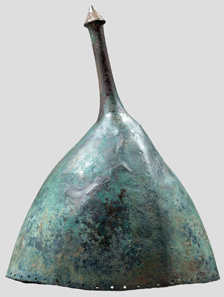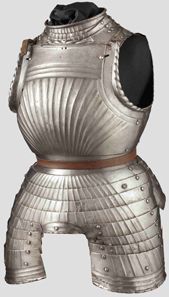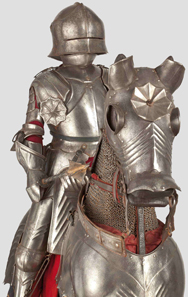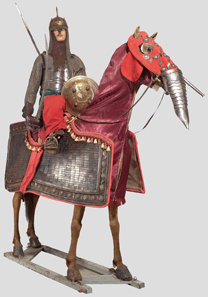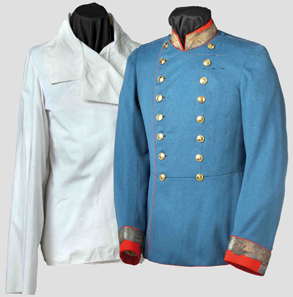03-11-2013 – 15-11-2013
67th auction
Antique arms and armours, decorations and militaria
With the usual wide range of high quality objects, this year’s Autumn Auction at Hermann Historica oHG will take place from 4th to 16th November. Approximately 8,000 lots from all specialist areas represented by the auction house – antiquities, arms and armour, works of art, hunting antiques, orders and collectibles from military history – will be auctioned.
Antiquities
Once again, this autumn sees a large number of early bronze helmets in outstanding condition in the antiquities section. Particularly impressive is a piece of ancient Oriental protective armour that is seldom found on the market:
an Assyrian conical bronze helmet dating from the 8th to the 7th century B.C. The position of the rivets on the two overlapping halves of the skull, with its mounted spike, is still clearly visible today. Extremely interesting, also from an academic perspective, the helmet is expected to fetch a minimum bid of 8,000 euros. Also up for auction are lot numbers 2036 and 2038; two objects that are characteristic examples of their kind. With the exquisite dark green patina of the heavy skull, a Greek Illyrian helmet dating from the 5th to the 4th century B.C. is open to bids from 16,000 euros, while a Greek Chalcidian helmet with full-faced tin-plating and the characteristic movable cheek pieces dating from the fourth century B.C. is estimated at 15,000 euros. Originating from the same period is a masterpiece of antique silversmith artistry, a late Scythian/early Sarmatian silver bowl. Partially gilt, this great rarity is engraved with a hunting scene in finest relief, depicting a steppe-nomadic rider poised to attack a wild boar. The work, whose rarity is matched only by its exquisite craftsmanship, has a starting price of 20,000 euros. More recent, yet no less interesting, is a perfectly preserved, early Byzantine reliquary cross in silver, dating from the tenth to the eleventh century. Elaborately and most attractively decorated, the magnificent, partially gilded crucifix will come under the hammer from 10,000 euros.
Arms and armour, arts and crafts
According to tradition, the arms and armour catalogue opens with hunting antiques and works of art. Up for auction here is a wide range of exclusive antique silver objects, like a partially gilt screw-top flask from Augsburg, dating from the end of the 17th century. Supported on four swamped ball feet, the body features decorative bosses and sparingly engraved foliage and is stamped on the base with the master’s mark of Paul Solanier, master from 1665 onwards. Standing 19 centimetres high and weighing almost 500 grams, the screw-top flask is estimated at 12,000 euros. Moreover, there is a particularly striking variety of carved ivory from bygone eras, including a German silver-mounted beaker from the 17th century. Depicting a continuously carved battle scene, the beaker has a reserve of 6,000 euros. Another example is a blowing horn from France, whose entire surface is decorated with a frieze of mythical creatures and portraits of French rulers, and measuring an impressive 87 centimetres along the external curve; bids are invited from 5,800 euros. A small collection of sundials, mostly originating in the 18th century, with estimates from 2,000 to 5,000 euros, round off the lots in this section.
Once more, exceptional collectors’ items are offered among the antique arms and armour. These include a Gothic breastplate, worked in two pieces, with manifold fluting on both sides and a Milan armourer’s mark, which was forged around 1480/90. Still bearing the original rivets for the straps and with silver rosettes in relief on the shoulders, the breastplate will come under the hammer from 15,000 euros.
For many years, Maximilian armour parts, their design as characteristic as it is decorative, have been much sought-after; such parts bear testimony to the fine armourer’s art of the early modern era. The group in this auction, comprising a breastplate with cuisses attached, collar, leg defences and ‘bear-paw’ sabatons, was forged in Nuremberg circa 1510/20. All armour parts display the typical, elaborate fluting with the turned and roped flanges. In addition to the optimal protection of the wearer, the armour was designed to ensure maximum comfort; therefore, all movable elements slide on multiple lames. This magnificent group of armour parts can be acquired for a minimum of 13,500 euros.
A true bijou of perfectly crafted armourer’s artistry attests to the exceptional skill of historicism blacksmiths in plying their trade. Coming under the hammer for 18,000 euros, the miniature set of armour for man and horse stands 1.54 metres tall and portrays knight and steed in full armour in late Medieval style. Of the finest quality, all armour parts have been modelled on the originals and are fully articulated and functional.
Once again, there is a magnificent range of rare helmets to choose from, like an early German bascinet from 1370, estimated at 12,000 euros, or a burgonet with pivoted bevor, fashioned in Augsburg around the middle of the 16th century, for which bids are invited from 9,500 euros. Outstanding among the edged weapons are a 9th century North European Viking sword, listed at 10,000 euros, and an extremely rare hunting weapon from the Hohenzollern Collection, Sigmaringen, a late-Gothic boar sword, which is up for auction for 7,500 euros.
Only optimal conditions can ensure the preservation of wooden and leather objects over the centuries, therefore the excellent condition of a Bernese pavise, made in Switzerland circa 1400, is all the more impressive. Fully covered in fine pigskin, the front of the untouched wooden oval shield has a coloured coating, consisting of a yellow bend on a red field on which the Bernese bear is painted down to the last detail. The sensational shield, the almost identical twin of which is documented in the Historical Museum of Bern, is offered for sale for 10,000 euros.
Africa, Orient and Asia
The quality and diversity of the lots from Africa, the Ottoman Empire, India, Japan and China remain as compelling as ever. Once again, there is a captivating array of splendidly crafted weapons from the Orient. For example, an exquisite gold-inlaid kard with a jade hilt and insets of rubies, diamonds and emeralds, dating from the 18th century, destined to take pride of place in a new collection for at least 7,000 euros. Further, a 17th century khanjar with an impressive offset silver grip decorated with dragon heads, probably from Balochistan/Afghanistan, which, on account of its rarity – only very few similar pieces have been published around the world – is expected to fetch a minimum bid of 9,500 euros. An example of superb chiselling craftsmanship with its sculpted depiction of a dragon, a peacock and a stork, the latter with a movable tongue, is a magnificent 17th century bichawa from Southern India. This distinguished weapon is estimated at 10,000 euros.
In addition, originating from the Indian subcontinent, a richly embellished, complete set of armour for a rider and his mount will come under the hammer starting from 15,000 euros. The set is made up of components from the 17th and 19th century, comprising a skull forged of blued steel and decorated with medallions and tendrils, a fine Northern Indian mail and lamellae shirt, which is almost certainly part of the group of shirts of this type captured in 1689 by Anup Singh, a lance, a tulwar and a horse armour of characteristic lamellae type with a quilted fabric chamfron and bridle.
Moreover, a particular feature of the auction are the delicate ivory carvings from China. While the appeal of the works lies in their awe-inspiring and masterly craftsmanship, the spectrum of objects ranges from a large carved ivory tusk dating from the 19th century depicting an exquisitely detailed landscape, with a starting price of 12,000 euros, right through to an ivory figure of Guanyin, the Daoist goddess of compassion, imbued with symbolism and offered for sale from 9,500 euros.
Military history and historical objects
Highly significant collectors’ items of remarkable, even imperial, provenance are up for auction again in the history and militaria section. Following the sale of the ‘Bonjourl’ belonging to the Austrian Emperor Franz Joseph I (1830-1916), which achieved the sensational final price of 140,000 euros in spring 2013, bids from 20,000 euros are now invited for his personal campaign tunic.
Of the highest quality, tailored in very fine, pike-grey cloth with a scarlet collar and gold-embroidered cuffs, the tunic was produced in 1916 by the imperial court purveyor ‘A. Uzel’ in Vienna and is known to have been worn by Kaiser Franz Joseph I. Other personal garments belonging to the Emperor include a bowler hat with the typical white lining and the label of the London hat maker ‘A.J. White’, with a starting price of 3,500 euros, and his personal general’s belt, made of gold braid interwoven with black, lined in imperial yellow silk, and estimated at 2,000 euros. The belt and bowler hat are from the estate of the emperor’s personal valet, Eugen Ketterl.
A piece of historical significance and museum quality, a personal gift from the Emperor Napoleon I (1769-1821) of stunning beauty and wrought with magnificent workmanship is being offered for auction at 40,000 euros. Made around 1800, the richly decorated snuff box in 18 carat gold is rendered in deep blue translucent enamel and bears a large mounted crowned Napoleonic coat of arms on the central cover. Napoleon presented this masterpiece, which was most likely produced by a Swiss workshop, as a mark of his appreciation to his long-serving and highly esteemed marshal Michel Ney, Prince de la Moskowa (1769-1815).
Equally appealing is a splendid Damascus presentation sabre for a high-ranking Prussian officer from the Wars of Liberation circa 1813, which is open to bids from 4,500 euros, or a beautifully preserved helmet for officers of the Saxon Horse Guard Regiment M 1854 until 1867, circa 1855, where even the delicate original gilding has withstood the passage of time without damage, with a starting price of 6,500 euros.
In addition, the plethora of Russian objects starts off with a major historical figure and one of his unique possessions. Etched with scrolls of foliage and acanthus leaves, the golden presentation sabre belonging to the Imperial Russian Field Marshal, conqueror of Napoleon and ‘the Saviour of St. Petersburg’ in 1812, Ludwig Adolf Peter, Prince of Sayn-Wittgenstein (1769-1843), stands out due to its fine mounting in three colours of gold. A significant object in very fine condition, the magnificent edged weapon is stamped with the Viennese gold hallmark of 1803 and the jeweller’s monogram of the eminent master Josef Wolfgang Schmidt. Where they coincide, rarity, condition and provenance may command their price, as reflected in the estimated price of the sabre, 80,000 euros. A precious work of fine quality that is associated with the tsarist court is a shashka M 1881/1909 for officers of the Russian dragoons with a personal dedication, which is listed at 20,000 euros. It was forged in the arts department of the Zlatoust arms factory and is embellished on both sides with gold-inlaid cartouches, some engraved with the double-headed eagle, some with the tsar’s cipher. Equally steeped in history but a great deal weightier are two Russian carronades, dated 1835, each barrel measuring a full 73.5 centimetres, which guarded the northern coastal approach to Kronstadt and St. Petersburg near Ekenäs at the Baltic sea for many years. The pair of guns are to come under the hammer for 55,000 euros.
Orders and Insignia
German states dominate the lots up for auction in the orders section. For the very first time, it is possible to acquire a Bavarian Order of Military Medical Merit 1st Class, this exemplar awarded to chief physician Dr. Alois Drisch, for 14,000 euros. In conformance with the high distinction of the award, the king concluded in 1918 that the white and blue enamelled golden cross with four arms was not to be worn on the chest but around the neck. Also on offer is a cross of the Prussian Pour le Mérite order, the mint condition of which is reflected in the listed price of 12,000 euros for this legendary decoration for bravery.
Fine antique and modern firearms
The pièces de résistance among the antique firearms boast a sensational rarity and quality that are otherwise difficult to obtain on the market.
The lots offered for auction are a collectors’ dream; first up is a high-grade, outstanding luxury wheellock pistol from Nuremberg, circa 1590/1600, which occupied pride of place in the armoury owned by the Prince of Schwarzburg-Rudolstadt for many years, but which was sold to the Berlin art trade back in 1926. Every last detail of the pistol will delight bidders with its fine quality: the root of the barrel is decorated with etched and gilt tendrils, the gun is stamped with hallmarks, has elaborate inlays made of engraved and partially coloured bone as well as engraved mother-of-pearl in the walnut stock. This decorative and interesting piece is expected to fetch a minimum of 35,000 euros. Also on offer for 27,500 euros is a very early and rare luxury pistol of the wheellock type from Brunswick or Munich. Richly embellished with hunting scenes, the weapon has been dated at 1550.
All prices are net prices and are to be understood plus 23 percent surcharge.
The auction catalogues are also available online at the Hermann Historica website.




